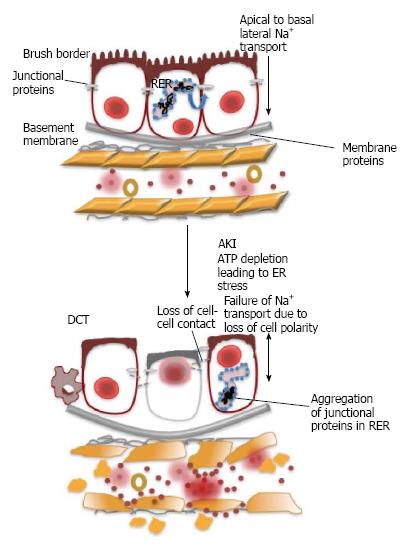Copyright
©2016 Baishideng Publishing Group Co.
World J Nephrol. Mar 6, 2016; 5(2): 139-146
Published online Mar 6, 2016. doi: 10.5527/wjn.v5.i2.139
Published online Mar 6, 2016. doi: 10.5527/wjn.v5.i2.139
Figure 1 Epithelial cell damage.
Ischemia reperfusion injury, sepsis or nephrotoxins are some the main causes of damage to epithelial cells resulting in AKI. The damage induces changes to the cytoskeleton, adhesion molecules and membrane proteins. ATP depletion results in the disruption of tight junctions causing back-leak of the filtrate as the actin cytoskeleton structure is altered. Endoplasmic reticulum stress caused by ATP depletion causes the aggregation of junctional proteins inducing an increase in the permeability of the endothelium. The loss of cell polarity due to AKI results in the failure of Na+ reabsorption allowing high concentrations of Na+ to reach the distal tubule stimulating an aberrant TGF response. AKI: Acute kidney injury; TGF: Tubuloglomerular feedback; ATP: Adenosine triphosphate; ER: Endoplasmic reticulum.
- Citation: Farooqi S, Dickhout JG. Major comorbid disease processes associated with increased incidence of acute kidney injury. World J Nephrol 2016; 5(2): 139-146
- URL: https://www.wjgnet.com/2220-6124/full/v5/i2/139.htm
- DOI: https://dx.doi.org/10.5527/wjn.v5.i2.139









